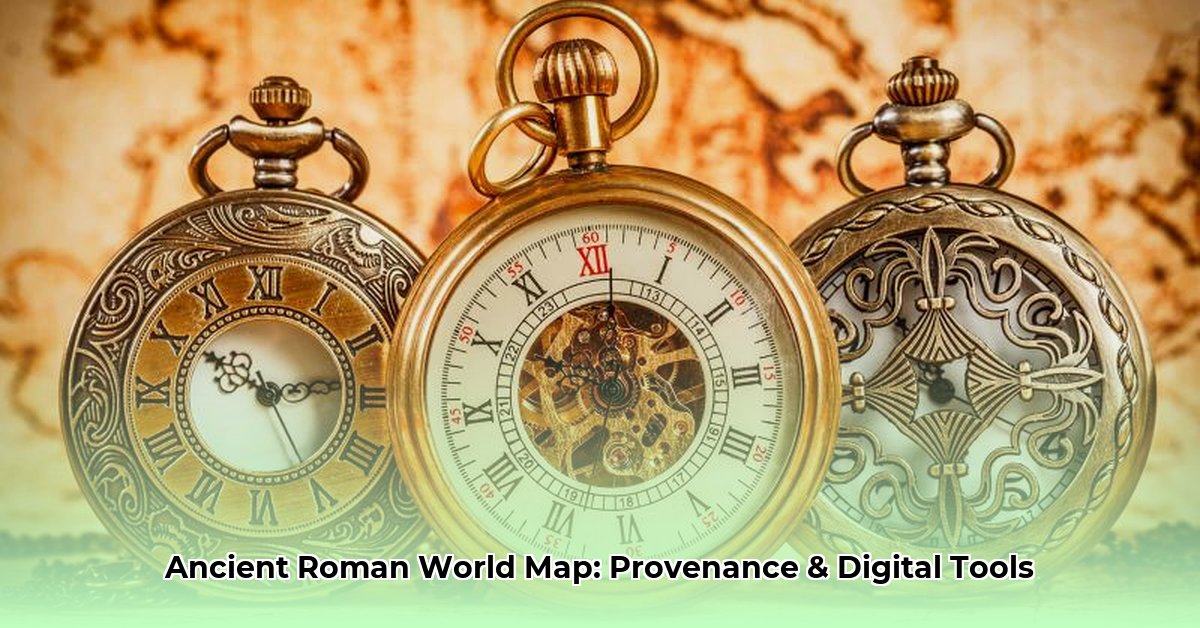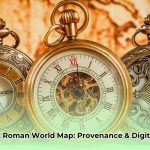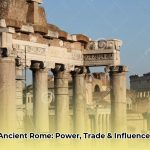Imagine holding a tangible piece of history, a meticulously crafted map that once charted the formidable expanse of the Roman Empire. Antique maps of the ancient Roman world offer precisely this profound connection—a direct link to an era of formidable emperors, disciplined legions, and sprawling road networks that once pulsed with unparalleled life. Look at more examples of Roman Empire maps for inspiration. This is more than merely acquiring an old piece of paper; it represents possessing a unique window into a bygone civilization. This guide serves as your trusted companion, whether you are contemplating a significant investment in a beautifully aged map or simply driven by a profound curiosity about the rich narratives these cartographic treasures hold. We will navigate the intricate art of identifying a genuine artifact, particularly those remarkable maps meticulously crafted by celebrated figures such as Heinrich Kiepert. Furthermore, we will delve into the critical aspects of their origins, their intrinsic valuation, and how cutting-edge digital technologies are fundamentally reshaping the landscape for discerning collectors and historical enthusiasts alike. Prepare to uncover the secrets that render these Roman cartographic relics so uniquely special, and understand their potential as a sagacious investment opportunity in today’s dynamic market.
The Historical Context of Roman Cartography: From Itinerary to Interpretation
Before delving into the specifics of antique maps depicting the Roman world, it’s crucial to understand the very nature of ancient Roman mapmaking. Unlike modern cartography, which prioritizes precise geographical accuracy, Roman maps served primarily pragmatic functions. Their fundamental purpose was to facilitate military logistics, consolidate administrative control, and chart the sprawling arteries of a vast empire. Think of them less as exact geographical replicas and more as intricate, functional diagrams of power, logistics, and communication.
- The Tabula Peutingeriana: A prime example of ancient Roman cartography is the Tabula Peutingeriana, a medieval copy of an ancient Roman road map depicting the cursus publicus, the road network of the Roman Empire. This extraordinary scroll, dating back to the 4th century AD, illustrates itineraries rather than precise geographical proportions, emphasizing routes, distances, and key stopping points. Its elongated, distorted depiction of continents serves its practical purpose as a travel guide for merchants and soldiers, highlighting the Roman emphasis on connectivity and control over spatial accuracy.
- Ptolemy’s Geographia: While not a “Roman” map in the traditional sense of being from the Roman administration, Claudius Ptolemy, a Roman citizen of Greek descent living in Alexandria (part of the Roman Empire), penned the influential Geographia in the 2nd century AD. This monumental work compiled geographical knowledge of the known world, establishing a system of latitudes and longitudes, and providing instructions for drawing maps. Though no original Ptolemaic maps survive, his detailed coordinates allowed later cartographers, from the Renaissance onwards, to reconstruct what are now considered “Ptolemaic maps,” heavily influencing subsequent depictions of the Roman world. These later interpretations, rather than direct Roman artifacts, are often what collectors encounter as “antique maps of the Roman world.”
Understanding this distinction—between scarce original Roman-era itinerary maps and the more common later antique maps depicting the Roman world—is fundamental for any serious collector. The maps discussed in this guide primarily fall into the latter category, crafted during the 18th, 19th, and early 20th centuries, and meticulously interpreting ancient knowledge.
How to Authenticate Antique Maps of the Roman World: A Collector’s Definitive Guide
For those venturing into the exhilarating pursuit of an antique map of the ancient Roman world, understanding its authenticity is paramount. The journey begins with recognizing that maps dating from the 18th and 19th centuries, though depicting ancient Rome, followed distinct production methodologies compared to modern cartography. Their primary intent was to reconstruct, interpret, and visually present historical geographical knowledge, often incorporating contemporary understanding alongside ancient texts.
Key Insights for Authentication:
- Antique maps depicting the Roman world primarily served educational, scholarly, and aesthetic purposes, aiming to reconstruct historical geography based on classical sources.
- Advanced digital tools, including augmented reality (AR) and artificial intelligence (AI), are increasingly enhancing the reconstruction, analysis, and understanding of these intricate historical cartographic pieces.
- Comprehending the scholarly and artistic intent behind these later mapmaking efforts offers crucial insights into their design, detail, and historical value.
The Art of Scrutiny: Unmasking Authenticity
Making sure your antique map of the ancient Roman world is the genuine article is a critical step in building a reputable and valuable collection. How, then, does one safeguard against clever forgeries or misattributions within this specialized niche? The answer lies in methodical inspection, rigorous historical research, and, when necessary, professional consultation.
Proven Steps to Verify Authenticity:
- Examine the Parchment or Paper: Upon closer inspection, does the medium betray the subtle characteristics of antiquity? Genuine antique paper or parchment often exhibits a distinct thickness, texture, and inherent irregularities not found in modern reproductions. Look for subtle watermarks—these hidden symbols, impressed into the paper during its manufacture, can provide crucial clues about the paper’s origin, mill, and precise era of production, much like a discreet cartographic signature. The presence of chain lines and laid lines, characteristic of handmade paper prior to the mid-19th century, is also a strong indicator of age.
- Decipher the Printing Technique: The particular printing method employed offers a definitive timeline for the map, allowing you to estimate its age with remarkable precision.
- Engraving (Copperplate or Steel Plate): Prevalent from the 16th to 19th centuries. Original engravings display a unique richness and depth; lines appear sharp and slightly raised, with subtle plate marks visible around the printed area where the copper or steel plate pressed into the paper.
- Lithography: Introduced in the late 18th century and popular in the 19th century. Lithographs typically have a flatter, softer quality of line without the distinct plate mark, as the image is printed from a stone rather than a raised plate.
- Woodcut: An older technique (pre-17th century, but used for some maps later). Lines are bolder, less precise, and often have a rustic quality.
Observing the characteristics of the line work under magnification can reveal the specific technique used, helping to date the map.
- Investigate the Cartographer’s Legacy: Conduct thorough research into the map’s creator. What was this cartographer renowned for? What other works bear their distinctive mark? This detailed knowledge helps you discern any inconsistencies and can be a significant indicator of its true origin and importance. For instance, a famous name like Heinrich Kiepert inherently suggests a higher level of historical fidelity and scholarly rigor. Always cross-reference the map to known works by the attributed cartographer.
- Seek a Professional Appraisal and Conservation Expertise: For a definitive answer on authenticity and condition, take the map to a professional appraiser who specializes exclusively in antique maps. Their expertise, honed over years of experience and deep market knowledge, provides an authoritative confirmation, offering peace of mind to any collector. Additionally, a professional paper conservator can assess the map’s physical stability, identify previous repairs, and recommend appropriate long-term preservation strategies.
- Trace the Map’s Provenance: Undeniably, the map’s journey through time is as captivating as the map itself. Where has it resided? Who were its previous custodians? Old records, historical ledgers, auction catalogs, or even family archives can sometimes reveal a robust chain of ownership (provenance), significantly bolstering the map’s value and credibility in the market. The documented story behind a map matters immensely; a well-documented provenance can profoundly enhance its worth as a historical artifact and investment.
The Digital Map Revolution: A Powerful Tool for Collectors
The advent of the internet has reshaped nearly every facet of human endeavor, including the specialized world of antique map collecting. The digital revolution has made antique maps of the ancient Roman world accessible to anyone with an internet connection, ushering in an era of unprecedented availability and new analytical possibilities. Is the transition towards owning, selling, and curating these historical documents digitally a beneficial one?
The Advantages and Disadvantages of Digital Cartography for Collection and Study:
| Feature | Distinct Advantages for Collectors and Researchers | Potential Drawbacks and Considerations |
|---|---|---|
| Accessibility | Offers unparalleled ease in discovering, researching, and browsing vast global collections from anywhere, facilitating cross-referencing and comparative study. | While digital images are abundant, ascertaining the true market value, physical rarity, or nuanced condition compared to an in-person inspection of physical maps can be significantly more challenging. |
| Interactivity | Provides dynamic tools for high-resolution zooming, overlaying historical data points (e.g., ancient roads on modern satellite imagery), and deep interactive learning experiences. | The irreplaceable tactile, aesthetic, and historical sensation of physically holding an authentic, aged map is entirely absent in the digital medium. |
| Preservation | Creates invaluable digital backups, eliminating primary concerns regarding physical degradation such as tearing, fading, or environmental damage to the original artifact. | The accuracy, color fidelity, and overall reliability of digital versions depend heavily on the original scanning quality, resolution, and the integrity of the digital source. |
| Educational Use | Transforms historical and geographical study into a fun, highly engaging, and interactive learning experience for students, researchers, and enthusiasts of all ages. | Potential copyright issues may arise when attempting to use or reproduce high-resolution digital scans for broader academic or commercial applications without proper licensing. |
| Authentication Aid | Digital databases of watermarks, printing techniques, and historical provenances can be rapidly cross-referenced, aiding initial authenticity checks remotely. | High-resolution digital forgeries are becoming more sophisticated, requiring collectors to exercise extreme caution and rely on expert verification for high-value acquisitions. |
What Determines Antique Roman Map Investment Potential Today
Considering an antique map of the ancient Roman world as a shrewd investment? This is a growing trend, as these maps represent not just historical documents but also exquisite works of art and tangible links to significant civilizations. However, determining their true investment potential requires a nuanced understanding of various contributing factors. It’s akin to assessing a rare vintage wine; its value is profoundly influenced by its vintage, its “vineyard” (cartographer), its condition, and its unique story. Notably, market data from platforms like 1stDibs indicates that an antique Roman map can range from $134 to $1,800, with an average selling price around $529, underscoring a diverse market.
Pivotal Factors for Investment Potential:
- Their scarcity, impeccable physical condition, the mapmaker’s established reputation, and the specific geographical focus are critically important for maximizing investment returns.
- Novice investors should always seek expert advice, prioritize maps that genuinely align with their personal interests, and commence their collecting journey with more accessible and affordable options.
- Seasoned collectors can strategically boost the value of their holdings through calculated diversification, meticulous provenance research, and adhering to superior preservation techniques.
Cracking the Code of Value and Investment
What transforms a mere historical relic into a highly coveted and valuable piece of history within the collector’s market? Several elements converge to define the valuation and investment appeal of an antique map depicting the Roman world:
- Rarity and Scarcity: If a map was produced in exceptionally limited quantities, represents a unique edition or state, or depicts rare or lost Roman settlements, its scarcity often translates directly into higher demand and a premium price from serious collectors. First editions or maps with unique annotations are particularly sought after.
- The Cartographer’s Pedigree: Maps crafted by renowned historical cartographers such as Abraham Ortelius, Gerard Mercator, or those like Heinrich Kiepert, celebrated for their meticulous accuracy and scholarly contributions, inherently command greater value. Their established reputation and profound historical significance contribute significantly to market desirability.
- Condition and Preservation: As with any high-value collectible, the map’s physical state is paramount. Maps in near-pristine condition, exhibiting minimal foxing (small brown spots caused by mold or impurities), discoloration, creasing, or fading, will always fetch a superior price. Conversely, severe tears, prominent stains, extensive repairs (especially amateur ones), or significant loss of material dramatically diminish both their aesthetic appeal and their market worth. Original hand-coloring that remains vibrant and stable is also a major plus.
- Aesthetic Allure and Artistic Merit: Beyond their historical data, maps that feature original hand-coloring, elaborate decorative borders, intricate allegorical cartouches, or vibrant pigments are often more visually captivating. The artistic quality of the engraving, the beauty of the calligraphy, and the overall design contribute significantly to their desirability, elevating their status as collectible art pieces.
- Historical Significance of Content: Maps that depict historically significant events, show the extent of the Roman Empire at a crucial period (e.g., under Trajan or Augustus), or highlight key Roman infrastructure like aqueducts or specific battle sites, often carry a higher value due to their narrative power and historical importance.
Strategic Approaches for Map Investment
Whether you are a newcomer eager to begin your collection or an experienced collector looking to refine and grow your portfolio, a strategic approach is essential for long-term success and enjoyment.
Actionable Steps for Emerging Collectors:
- Seek Expert Guidance and Build Relationships: Forge lasting relationships with reputable antique map dealers. Their seasoned advice, deep market knowledge, and authentication services are indispensable directional tools in this intricate and often nuanced world. Attend reputable antique map fairs and auctions to meet dealers in person.
- Follow Your Intrinsic Passion: Prioritize maps that genuinely captivate your interest. Whether it’s maps detailing specific Roman emperors’ reigns, maps charting ancient trade routes, or those focusing on particular regions of the Roman Empire, personal connection often leads to more rewarding long-term collecting and appreciation.
- Initiate with Accessible Options: Begin your journey with more affordable regional maps or less prominent editions. This allows you to gain invaluable experience, understand market intricacies, and refine your collecting eye without a substantial initial outlay, building confidence gradually.
- Prioritize Authentication and Documentation: Always insist on robust, written guarantees of authenticity from trusted dealers, specifying the map’s origin, date, and cartographer. Furthermore, consult independent authentication experts and diligently examine factors like paper quality, printing techniques, and distinct watermarks to confirm its legitimacy before purchase. Request detailed condition reports and high-resolution images.
Advanced Strategies for Seasoned Collectors:
- Diversify Your Collection Strategically: Explore expanding your portfolio to include maps depicting regions or periods that are gaining increasing market interest, or those from cartographers whose works are projected to appreciate. Diversification can hedge against market fluctuations for specific types of maps.
- Unearth Deeper Provenance Research: Dedicate time and resources to meticulously research a map’s full ownership history. Discovering a significant past owner (e.g., a famous library or historical figure) or an established, continuous chain of custody can dramatically elevate its historical and monetary value, making it highly desirable.
- Elevate Preservation Standards: Invest in premium archival-quality storage materials and adopt best practices for handling. This includes using acid-free matting and backing, UV-protective glazing for framed maps, and storing unframed maps in climate-controlled environments. Controlling exposure to humidity, light, and airborne contaminants ensures the map’s condition is maintained, securing its long-term appreciation.
- Stay Continuously Informed and Network: Cultivate strong relationships with prominent auction houses, specialized dealers, and professional appraisers. This robust network will keep you abreast of the latest market trends, auction results, and emerging scholarship, helping to optimize both buying and selling strategies and identify rare opportunities. Engage with collector communities and academic forums.
Navigating the Risks in Antique Map Investment
While the allure of antique maps as an investment is compelling and potentially rewarding, it is crucial for collectors to acknowledge and proactively mitigate potential risks. Prudent planning and due diligence can significantly safeguard your valuable acquisitions and enhance your collecting experience.
| Investment Risk | Comprehensive Description of the Challenge | Robust Mitigation Strategy and Best Practices |
|---|---|---|
| Authentication Challenges | The significant risk of inadvertently acquiring forgeries, reproductions, or misattributed pieces that lack genuine historical value, thereby leading to substantial financial loss and undermining collection integrity. | Always obtain robust, written guarantees of authenticity from highly reputable and established dealers who specialize in antique maps. Systematically consult independent, specialized authentication experts for high-value acquisitions. Meticulously examine the map’s paper composition, printing techniques (e.g., plate marks, line quality), and distinctive watermarks, cross-referencing with known historical examples. Research the cartographer’s signatures and styles. |
| Condition Deterioration | Irreversible physical damage resulting from improper storage, negligent handling, or adverse environmental factors such as excessive humidity (leading to foxing/mold), direct light exposure (causing fading), extreme temperature fluctuations (leading to brittleness), or physical tearing and creasing. | Invest in premium archival-quality storage materials including acid-free mats, UV-protective glazing, and Mylar sleeves or portfolios. Adhere strictly to best handling practices, always using clean hands or cotton gloves. Implement rigorous climate control for humidity (ideally 45-55% RH) and temperature (stable, cool environment) in storage areas. Secure comprehensive, specialized insurance coverage for all high-value maps to protect against damage or loss. |
| Market Fluctuations | Unpredictable shifts in collector preferences, broader economic downturns, changes in historical appreciation or academic interest, or the emergence of new technologies that can impact map values, sometimes significantly and unexpectedly. | Diversify your map collection across varied geographical regions, distinct historical periods, and works by prominent and diverse cartographers. Remain continuously informed on prevailing market trends by diligently tracking auction results from leading houses (e.g., Sotheby’s, Christie’s, Swann Galleries) and engaging with established dealer networks and academic publications. Consider a long-term holding strategy rather than short-term gains. |
| Illiquidity | The inherent challenge of swiftly selling high-value, niche collectibles when immediate liquidation of assets is required, as the market for such specialized items is comparatively smaller and less active than mainstream investments. | Proactively establish strong, trusting relationships with established auction houses and reputable dealers well in advance to facilitate smoother and more efficient sales processes when the time comes. Explore consignment options as an alternative to direct sales. Cultivate and maintain a reputation as a serious and knowledgeable collector within the community, which can ease future transactions. Consider a clear exit strategy for your collection. |
Heinrich Kiepert’s Maps: Essential Collector’s Provenance Insights and Enduring Legacy
For any serious collector of antique maps of the ancient Roman world, the name Heinrich Kiepert (1818-1899) resonates with particular and profound significance. He was not merely a cartographer drawing lines on a page; he was a meticulous scholar, a dedicated explorer, and a pivotal figure in accurately reconstructing the historical geography of antiquity. His enduring legacy offers crucial provenance insights and a hallmark of quality for anyone seeking to acquire his exceptional works.
Key Enduring Contributions of Heinrich Kiepert:
- Heinrich Kiepert revolutionized historical cartography through his painstaking comparative research, critical analysis of ancient sources, and innovative mapping techniques, particularly focusing on the classical and Ottoman worlds.
- His maps are consistently distinguished by their exceptional accuracy, remarkable clarity of detail, and aesthetic legibility, setting an unprecedented standard for geographical representation in the 19th century.
- Kiepert’s strategic and pivotal collaboration with Dietrich Reimer, a renowned Berlin publisher, ensured the superior production quality, widespread legibility, and extensive distribution of his meticulously crafted published works.
- His comprehensive and extensive body of work continues to stand as an invaluable, indispensable resource for contemporary historians and cartographers, providing profound insights into 19th-century geographical knowledge and scholarly methodologies.
- The widespread digital access to Kiepert’s cartographic masterpieces, particularly through esteemed institutions like the University of Chicago Library, greatly enhances their global accessibility for researchers, students, and passionate enthusiasts.
Kiepert’s Cartographic Prowess and Historical Impact
Heinrich Kiepert’s profound impact on historical cartography stemmed from his unwavering commitment to accuracy, his deep immersion in classical geography, and his pioneering use of robust source criticism. His early collaboration with Carl Ritter on the Atlas von Hellas und den hellenischen Kolonien (Atlas of Greece and the Hellenic Colonies) in 1840 exemplifies his dedication to rectifying existing inaccuracies in educational materials. Can you imagine the profound effect of providing students and scholars with such meticulously researched and precise maps, allowing them to visualize ancient civilizations with unprecedented clarity and fidelity? He meticulously cross-referenced classical texts (like Strabo, Ptolemy, Caesar, and Livy) with contemporary archaeological discoveries, a revolutionary approach for his time.
Pioneering Maps of the Ottoman Empire and Beyond
Kiepert’s expeditions extended far beyond the classical realm. Between 1841 and 1848, he embarked on extensive, often perilous, journeys throughout the Ottoman Empire, particularly traversing Asia Minor (modern-day Turkey). These expeditions, frequently undertaken in dangerous conditions, resulted in maps that were, at the time, considered the most reliable, accurate, and highly detailed available. These groundbreaking depictions filled critical gaps in the world’s geographical knowledge, correcting centuries of misconceptions. Picture the immense thrill of discovering and contributing such vital, transformative information about a region previously shrouded in cartographic mystery and imprecision! His work on the Ottoman Empire was instrumental for diplomats, military strategists, and explorers.
Unwavering Commitment to Clarity and Precision
Kiepert’s dedication to clarity and precision is a defining characteristic across his entire body of work, profoundly evident in seminal atlases such as the Atlas Antiquus (1854), Grosser Handatlas (Large Hand Atlas), and Formae Orbis Antiqui (Shapes of the Ancient World, 1894). His meticulous attention to detail, steadfast pursuit of accuracy, and commitment to aesthetic clarity established a gold standard for his era. Even with modern advancements in geographical understanding and digital mapping, his maps retain immense scholarly and historical significance, offering not only a precise glimpse into historical landscapes but also illuminating the fascinating evolution of cartographic methodologies and the intellectual rigor of 19th-century scholarship.
A Prolific Career and Enduring Collaborations
From 1845 to 1852, Kiepert distinguished himself as the director of the prestigious Geographisches Institut in Weimar. Subsequently, in 1854, he assumed the esteemed role of a geography professor at the venerable University of Berlin, a position he held for decades, shaping generations of geographers. His pivotal professional alliance with Dietrich Reimer, a renowned Berlin publisher celebrated for the exceptional legibility, precision, and artistic quality of his printed maps, was absolutely instrumental to Kiepert’s widespread impact and accessibility. Beyond his foundational work on the Ottoman Empire, Kiepert produced pioneering ethnic maps of diverse regions, including the complex Balkan Peninsula, the expansive Austria-Hungary, and a newly unified Germany, thereby broadening his profound influence across both historical and cultural cartography. These ethnic maps, while reflecting 19th-century ethnographic understanding, provided crucial visual data for geopolitical analysis.
Empowering Access Through Digital Collections
The University of Chicago Library proudly curates a substantial and invaluable collection of Kiepert’s










